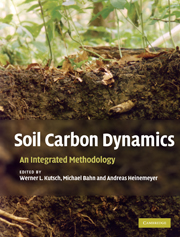Book contents
- Frontmatter
- Contents
- List of Contributors
- Preface
- Editorial Acknowledgements
- 1 Soil carbon relations: an overview
- 2 Field measurements of soil respiration: principles and constraints, potentials and limitations of different methods
- 3 Experimental design: scaling up in time and space, and its statistical considerations
- 4 Determination of soil carbon stocks and changes
- 5 Litter decomposition: concepts, methods and future perspectives
- 6 Characterization of soil organic matter
- 7 Respiration from roots and the mycorrhizosphere
- 8 Separating autotrophic and heterotrophic components of soil respiration: lessons learned from trenching and related root-exclusion experiments
- 9 Measuring soil microbial parameters relevant for soil carbon fluxes
- 10 Trophic interactions and their implications for soil carbon fluxes
- 11 Semi-empirical modelling of the response of soil respiration to environmental factors in laboratory and field conditions
- 12 Modelling soil carbon dynamics
- 13 The role of soils in the Kyoto Protocol
- 14 Synthesis: emerging issues and challenges for an integrated understanding of soil carbon fluxes
- 15 Appendix: Towards a standardized protocol for the measurement of soil CO2 efflux
- Index
- References
15 - Appendix: Towards a standardized protocol for the measurement of soil CO2 efflux
Published online by Cambridge University Press: 11 May 2010
- Frontmatter
- Contents
- List of Contributors
- Preface
- Editorial Acknowledgements
- 1 Soil carbon relations: an overview
- 2 Field measurements of soil respiration: principles and constraints, potentials and limitations of different methods
- 3 Experimental design: scaling up in time and space, and its statistical considerations
- 4 Determination of soil carbon stocks and changes
- 5 Litter decomposition: concepts, methods and future perspectives
- 6 Characterization of soil organic matter
- 7 Respiration from roots and the mycorrhizosphere
- 8 Separating autotrophic and heterotrophic components of soil respiration: lessons learned from trenching and related root-exclusion experiments
- 9 Measuring soil microbial parameters relevant for soil carbon fluxes
- 10 Trophic interactions and their implications for soil carbon fluxes
- 11 Semi-empirical modelling of the response of soil respiration to environmental factors in laboratory and field conditions
- 12 Modelling soil carbon dynamics
- 13 The role of soils in the Kyoto Protocol
- 14 Synthesis: emerging issues and challenges for an integrated understanding of soil carbon fluxes
- 15 Appendix: Towards a standardized protocol for the measurement of soil CO2 efflux
- Index
- References
Summary
INTRODUCTION
Soil CO2 efflux, more commonly termed soil respiration, is considered to be the second largest flux of carbon between terrestrial ecosystems and the atmosphere. Current estimates of global soil respiration are in the range of 68–80 Pg C a−1 (Raich and Potter, 1995; Raich et al., 2002), which exceeds estimated annual rates from fossil fuel combustion by an order of magnitude (Schlesinger and Andrews, 2000; IPCC, 2007). It must be noted that these estimates of global soil CO2 efflux are based on a very limited dataset: (1) the distribution of data for biomes is biased towards forests in the Northern hemisphere; (2) a considerable proportion of the data is based on static chamber measurements, which tend to underestimate soil respiration at high flux rates (Norman et al., 1997; Chapter 2, Pumpanen et al.); (3) annual estimates are often based on simplistic relationships (generally only temperature and sometimes also soil moisture) that capture only a limited fraction of the diurnal, seasonal, annual and inter-annual variation of soil respiration and (4) the spatial variation of soil respiration is generally not well captured, both within ecosystems and across similar ecosystems at a regional scale.
A further major problem for obtaining sensible estimates of global soil CO2 efflux is related to the fact that even though an increasing amount of data is becoming available, these more recent datasets are often not easily comparable due to different methodologies and to the limited availability of ancillary parameters.
- Type
- Chapter
- Information
- Soil Carbon DynamicsAn Integrated Methodology, pp. 272 - 280Publisher: Cambridge University PressPrint publication year: 2010
References
- 3
- Cited by

